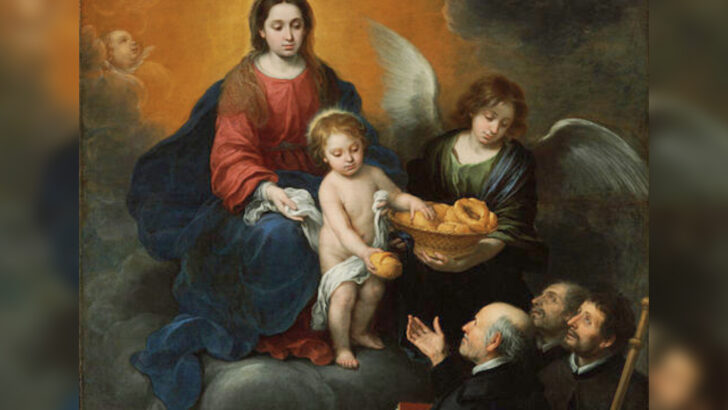Catechism of the Catholic Church
The Apostles’ Creed professes that God is “creator of Heaven and Earth.” The Nicene Creed makes it explicit that this profession includes “all that is, seen and unseen,” meaning ‘all that exists’, creation in its entirety. It also indicates the bond, deep within creation between Heaven and Earth.
‘The Earth’ is the world of men, while ‘Haven’ can designate both the firmament and God’s own place. Finally, ‘Heaven’ refers to the saints and the place of the spiritual creatures, the angels, who surround God.
The angels
The existence of the spiritual, non-corporeal beings that Sacred Scripture usually calls “angels” is a truth of faith. St Augustine said, “‘Angel’ is the name of their office, not of their nature. If you seek the name of their nature, it is ‘spirit’.” As purely spiritual creatures, angels have intelligence and will. Christ is the centre of the angelic world. They are his angels. They belong to him because they were created through and for him.
Angels have been present since creation and throughout the history of salvation, announcing this salvation from afar or near and serving the accomplishment of the divine plan: they closed the earthly paradise; protected Lot; saved Hagar and her child; stayed Abraham’s hand; communicated the law by their ministry; led the People of God; announced births and callings; and assisted the prophets, just to cite a few examples. Finally, the angel Gabriel announced the birth of the Precursor and that of Jesus himself.
From the Incarnation to the Ascension, the life of the Word incarnate is surrounded by the adoration and service of angels. It is the angels who ‘evangelise’ by proclaiming the Good News of Christ’s Incarnation and Resurrection. They will be present at Christ’s return, which they will announce, to serve at his judgement.
The angels in the life of the Church
In her liturgy, the Church joins with the angels to adore the thrice-holy God. She invokes their assistance. From infancy to death human life is surrounded by their watchful care and intercession. “Beside each believer stands an angel as protector and shepherd leading him to life.”
God himself created the visible world in all its richness, diversity and order. Scripture presents the work of the Creator symbolically as a succession of six days of divine “work”, concluded by the “rest” of the seventh day. Nothing exists that does not owe its existence to God the Creator.
Each creature possesses its own goodness and perfection. For each one of the works of the “six days” it is said: “and God saw that it was good.” God wills the interdependence of creatures. the sun and the moon, the cedar and the little flower… Creatures exist only in dependence on each other, to complete each other, in the service of each other.
The visible world
The beauty of the universe: the order and harmony of the created world results from the diversity of beings and from the relationships which exist among them. Man discovers them progressively as the laws of nature. The beauty of creation reflects the infinite beauty of the Creator and ought to inspire the respect and submission of man’s intellect and will.
The hierarchy of creatures is expressed by the order of the “six days”, from the less perfect to the more perfect. Man is the summit of the Creator’s work, as the inspired account expresses by clearly distinguishing the creation of man from that of the other creatures.
In creation God laid a foundation and established laws that remain firm, on which the believer can rely with confidence, for they are the sign and pledge of the unshakeable faithfulness of God’s covenant. Creation was fashioned with a view to the sabbath and therefore for the worship and adoration of God. Worship is inscribed in the order of creation.


 Renata Milán Morales
Renata Milán Morales
